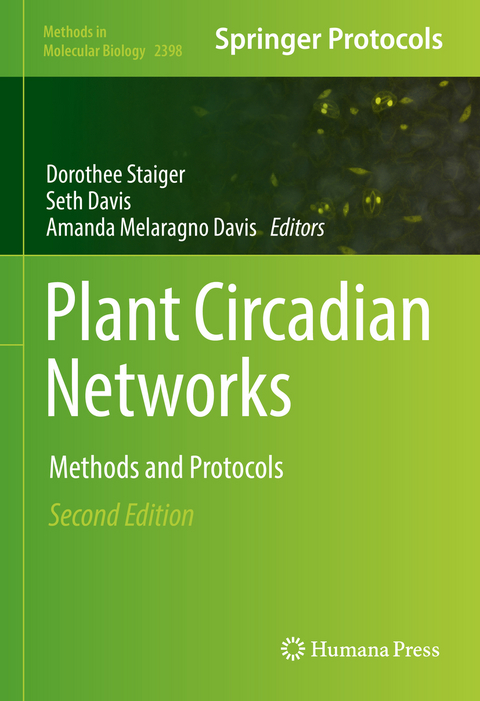
Plant Circadian Networks
Springer-Verlag New York Inc.
978-1-0716-1911-7 (ISBN)
Authoritative and practical, Plant Circadian Networks: Methods and Protocols, Second Edition is designed not only for the chronobiology community dealing with circadian biology but also for the plant community in general.
“Period estimation and rhythm detection in timeseries data using BioDare2, the free, online, community resource” is available open access under a Creative Commons Attribution 4.0 International License via link.springer.com.
Circadian Rhythm: Phase Response Curve and Light Entrainment.- Period Estimation and Rhythm Detection in Timeseries Data Using BioDare2, the Free, Online, Community Resource.- Detection and Analysis of Circadian Rhythms Via Prompt Chlorophyll Fluorescence.- High Spatial Resolution Luciferase Imaging of the Arabidopsis thaliana Circadian Clock.- Agrobacterium-mediated seedling transformation to measure circadian rhythms in Arabidopsis.- Measurement of Luciferase Rhythms in Soybean Hairy Roots.-ODE (ordinary differential equation) Models for Plant Circadian Networks: What The Models Are, and How They Should Be Used.- How to Detect QTLs in the Plant Circadian Clock.- Measuring Hypocotyl Length in Arabidopsis.- High Throughput Extraction and Enzymatic Determination of Sugars and Fructans In Fructan-Accumulating Plants.- Simple Nuclei Preparation and Co-Immunoprecipitation Procedures for Studying Protein Abundance and Interactions In Plant Circadian Time Courses.- Chromatin Immunoprecipitation Protocol for Circadian Clock Proteins.- A high-throughput 3′-Tag RNA Sequencing for Large-Scale Time-Series Transcriptome Studies.- Experimental Design for Time-Series RNA-seq Analysis of Gene Expression and Alternative Splicing.- Using tandem affinity purification to identify circadian clock protein complexes from Arabidopsis.- Firefly Luciferase Complementation-Based Analysis of Dynamic Protein-Protein Interactions under Diurnal and Circadian Conditions in Arabidopsis.- Monitoring Seasonal Bud Set, Bud Burst, and Cold Hardiness in Populus.- The Perennial Clock Is an Essential Timer for Seasonal Growth Events and Cold Hardiness.
| Erscheinungsdatum | 29.10.2021 |
|---|---|
| Reihe/Serie | Methods in Molecular Biology ; 2398 |
| Zusatzinfo | 33 Illustrations, color; 17 Illustrations, black and white; XI, 245 p. 50 illus., 33 illus. in color. |
| Verlagsort | New York, NY |
| Sprache | englisch |
| Maße | 178 x 254 mm |
| Themenwelt | Naturwissenschaften ► Biologie ► Botanik |
| Schlagworte | chemical screens • Circadian ChIP • Circadian transcriptomics • Luciferase measurements • Single cell rhythms |
| ISBN-10 | 1-0716-1911-X / 107161911X |
| ISBN-13 | 978-1-0716-1911-7 / 9781071619117 |
| Zustand | Neuware |
| Informationen gemäß Produktsicherheitsverordnung (GPSR) | |
| Haben Sie eine Frage zum Produkt? |
aus dem Bereich


